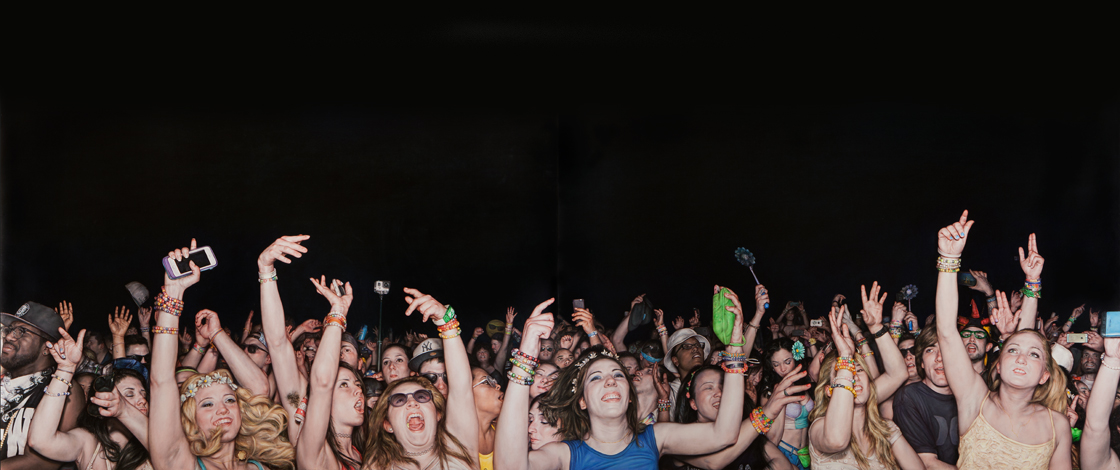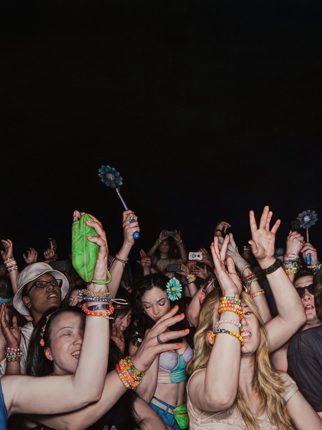Capturing Rapture: The Paintings of Dan Witz

Dan Witz, known for his hardcore mosh pit paintings and street art, attended last year’s EDC New York in hopes of finding some new inspiration. Lucky for us, he did. In anticipation of his latest electronic music festival-inspired piece, I visited Dan at his home and studio in Brooklyn to get the 411. After he buzzed me through the all-too-familiar double-door residential airlock, I climbed a calf-burning flight of stairs to meet him. Sporting a plaid button-down with the sleeves ripped off to expose his tattoo-covered arms and a mop of grey hair, he greeted me with a warm smile and a friendly handshake.
He led me through a maze of art detritus to a modest room covered in paint splatters and his latest triumph. Mounted on the living room wall, which most would reserve for their flat-screen TV, were two oversize side-by-side canvases depicting a frenzy of young people in a clear moment of catharsis. I swear I could feel the bass and smell the sweat. It made me instantly sad for having missed the festival last summer; I should have been there to witness the energy myself.
Over the next hour, our conversation moved seamlessly between the old painting masters, punk rock, techno, photography, transgression, aggression, and DJ culture.

How did the EDC piece come about?
I usually paint hardcore shows… but I have some friends who knew someone who knew someone at EDC, and they got us in touch. I got an all-access photo pass to get backstage and to all the different areas, so I just cruised around all day and took photos. I went there with an idea in my head for one of my normal paintings and took probably 500 photos, but was so blown away by the experience and the insanity; being in that moat with 50,000 people, it totally changed my perspective (laughs). I have been painting these mosh pits for like 10 years, really enjoying it and having a great time, but getting tired of painting… white men with shaved heads and tattoos. So I really wanted to do a female counterpart to my male work, and I was really interested in different skin tones.

Was that a challenge?
Yes, in a good way. That’s something that keeps it interesting for me. I went there with that in mind—the idea of capturing this moment of ecstasy, of transport and rapture.

Do you remember what music was playing when you took your source photos?
I made sure I was in place when Tiësto went on. I know his stuff and like him… so most of this was from when he was playing. This is not what I intended when I went, but I was like, “I’m here at EDC, so I’d better take these photographs.” Fortunately, I took like a hundred of these at moments of explosion.
How do you put together a piece like this? Are you painting a representation of a photograph you took?
I am an academic realist… a traditional, technical painter with transgressive narratives. Usually, the technical part is really a totally separate thing from the conceptualizing, the photographing, or even the composing. Once I start painting, it’s a matter of underpainting, drawing, glazes, figuring out the color… I work in layers, like the old masters, so I work in monochrome and build it up. It’s pretty much a traditional slog once I get the thing on canvas and start.
The characters are all based on photographs of people collaged together. So, it’s a lot of Photoshop, a lot of puzzling together, a lot of choosing some main characters and some subsidiary characters, changing the lighting and clothing. I definitely took things out that I didn’t care for—some macho stuff, some women exploitation stuff—I don’t want people to focus on that. I want them to experience this moment and identify with it. I want them to leave their perception of reality with me.

What is the most fun about making one of these pieces?
I think the most fun is taking the pictures.
So, why not do photography?
That’s a good question. Photographs, which are flat and informational, don’t have a presence or an impact. I try to give the people souls and being that only a painting can give. I am not against photography but would not capture the energy of this moment without using all the tricks of the realist painters’ trade. Everything is sort of accentuated and amplified. A photograph is just pretty much a flat representation of reality; a painting is my interpretation of it. I paint photorealistically, but I don’t think they look like photos at all. Even a photograph of the painting, it doesn’t really look like a photo. It looks like a slightly tilted alternate reality that maybe expresses that reality better than a photograph could.
How long did the painting take you to make?
This one is the biggest one I have ever done, so this one took at least six months. It took a lot out of me—a lot of gray hair (laughs).
How does technology play a part in your work? Does it speed up the process?
Unfortunately, it doesn’t help me make the painting any faster, but it allows me to do the things that I couldn’t have done… [that] I wouldn’t have even thought I could do if I didn’t know what “free transform” meant in Photoshop. I think Photoshop is as important a medium as oil paint. It has the unlimited potential and goes to the magic on its own… Technology has allowed me to conceptualize things I couldn’t have before.

Your work regularly depicts subcultures. Are you trying to document subcultures with your work?
There is a subtext there, but I am not really interested in documenting subcultures at all. I was attracted to the hardcore thing because of my past in those bands and the utterly authentic “barbaric yawp” (from verse 52 of Walt Whitman’s “Song of Myself”) of that kind of music. The EDC painting is called WOMP, which is the rave word for that deep bass tone—that gut-wrenching bass note.
Do you listen to music when you work?
Yeah, I have a kind of ambient, low-key vibe. I’m into dub… certainly not anything as aggressive as techno or the stuff they play at raves. I do like some of that music a lot, and I think that in the more underground DJ culture, it is the most interesting music that is being done now.
Do you draw any parallels between your work and music?
There is definitely a correlation between sampling and what I do. Sampling technology in music gave me the idea that I could sample my own photographs, distort them and integrate them, and make different tracks, basically. There’s always a correlation between what’s going on between music, art, dance and literature.
Do you think DJs compare to musicians?
Good ones? By all means, yeah. I think DJ technology is as valid an instrument as anything; using that is a skill as important as playing a bassoon or shredding a guitar. DJs, arranging, sampling—they can make magic! I think rock ‘n’ roll is just some interpretive stuff now; it is very rarely original or something new. The ambient, and the sampling, and the DJ music is the only thing that seems to be imaging a future. This is what someone like me needs to feed on—some of that minimalist, crazy, distorted drum sample stuff—a buzzing bass that’s in your gizzard. That’s pretty profound, I think.
Who are your favorite artists?
That’s a shifting cast of characters. There is a show up now at the Met Breuer called Unfinished, where I saw a few Titian paintings that just blew my mind. Duchamp—the man’s brilliant… he’s one of my heroes. Andy Warhol—the man’s a genius. He’s probably one of the five greatest artists of the 20th century, in my opinion.

Is it the technical execution of their work, or the ideas, or…?
It is the shift in consciousness that each of these guys provided for the world that causes people to re-evaluate all sorts of values and things in their lives. It’s what I look for in an artist. I like things that shift culture; that’s my thing.
You have been making street art since before it was so popular. Are you still doing that work?
Crazy doing street art. Next, I am going to Worcester, MA, to put up these windows. These are going to look hilarious on the street. This is sort of my global warming pitch. These are my Deluvians, people of the flood or deluge… We are all about to be underwater. I did all these interventions on the London phone booths. I had all these people meditating in phone booths or doing spiritual practices. This was a reaction to the Paris bombings.
Are you feeding current events and politics into your work?
It’s always been there. All the street art always has had a subtext, but it will persist without people knowing that this is the inspiration. I have worked with Amnesty International, I’ve worked with PETA, I have worked on specific campaigns. In the last few years, I have aligned myself with human rights organizations. I am a big animal-rights guy; I am concerned with animal agriculture and the effect on the environment.
You seem to have exhibited all over the world. Where to next?
I just got back from London, did a huge thing there, then to Dresden. I’m going to Paris in October.
It’s like being a touring musician.
Yeah—I don’t make a lot of money, but I get to travel around the world. Nine times out of 10, I get to bring my wife and kid with me. My kid is not even 5, and he’s been to Europe 12 times. His passport is hilarious (laughs).
Follow Dan Witz on Facebook | Twitter | Instagram


